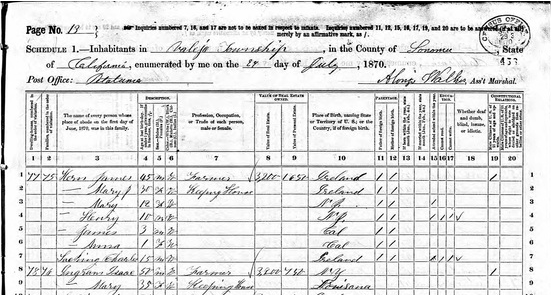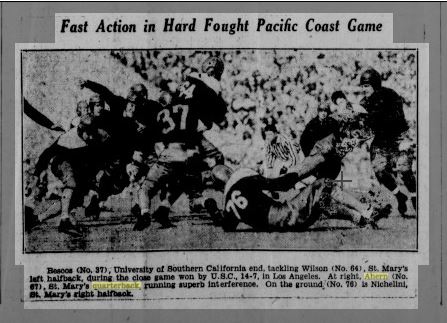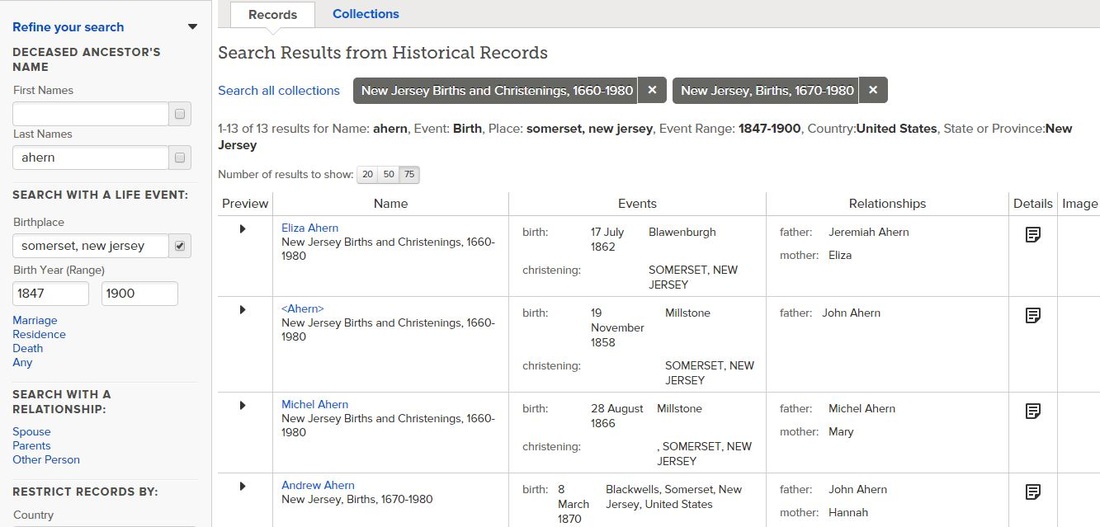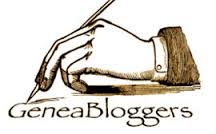 Crocker-Langley San Francisco Directory for the Year Commencing May 1905, (San Francisco, California: H.S. Crocker Company, 1905), page 1180. From Ancestry.com Crocker-Langley San Francisco Directory for the Year Commencing May 1905, (San Francisco, California: H.S. Crocker Company, 1905), page 1180. From Ancestry.com City directories are a great resource for solving all sorts of genealogical problems. Here’s one way you can use them to narrow down a marriage date – and even find the husband! – when a woman marries. My great-great uncle, Henry Ahern, was married to Rebecca Calkins sometime in the early 1890s. I haven’t been able to find the marriage record, but their boys, William Henry and James Bernard were born in 1894[1] and 1896.[2] A few years later, Henry passed away.[3] Rebecca Ahern, widow, appears in the 1900 San Francisco City Directory residing at 2770 21st, the same address mentioned in Henry’s obituary.[4] In 1901, she appears in the San Francisco directory residing at 1790 Folsom,[5] and she continues to live at the same address in 1902,[6] 1903[7] and 1904, where she is listed as working in a bakery[8]. Also living at the same address in 1901-1905 is Rebecca’s widowed mother, Nora Calkins. No listing Rebecca Ahern appears in the 1905 San Francisco directory. But a search using the address, 1790 Folsom, turns up a Mrs. Rebecca Macy, working in a bakery. At the same address is Orlando Macy, a blacksmith.[9] With the information from the directories, I was able to narrow down the time frame in which Rebecca Ahern remarried and the name of her husband. A newspaper announcement in August of 1904 shows a marriage license issued for Orlando Macy, 1716 Folsom street, age 36, and Rebecca Ahern, 1719 Folsom street, age 32.[10] Try searching city directories by address as well as by name. You might just solve one of your vexing genealogical questions! [1]"California Death Index, 1940-1997," database, FamilySearch (https://familysearch.org/ark:/61903/1:1:VPNJ-CJD : 26 November 2014), William H Ahern, 19 Sep 1977; Department of Public Health Services, Sacramento. [2]"California Death Index, 1940-1997," database, FamilySearch (https://familysearch.org/ark:/61903/1:1:VPCW-G3P : 26 November 2014), James B Ahern, 08 Jul 1957; Department of Public Health Services, Sacramento. [3] “Deaths: Ahern,” San Francisco Chronicle, 16 February 1900, p. 10, col. 4. [4] Crocker-Langley San Francisco Directory for the Year Commencing May 1900, (San Francisco, California: H.S. Crocker Company, 1900), 170. From Ancestry.com. U.S. City Directories, 1822-1995 [database on-line]. Provo, UT, USA: Ancestry.com Operations, Inc., 2011. [5] Crocker-Langley San Francisco Directory for the Year Commencing May 1901, (San Francisco, California: H.S. Crocker Company, 1901), 170. From Ancestry.com. U.S. City Directories, 1822-1995 [database on-line]. Provo, UT, USA: Ancestry.com Operations, Inc., 2011 [6] Crocker-Langley San Francisco Directory for the Year Commencing May 1902, (San Francisco, California: H.S. Crocker Company, 1902), 170. From Fold3.com. [7] Crocker-Langley San Francisco Directory for the Year Commencing May 1903, (San Francisco, California: H.S. Crocker Company, 1903), 170. From Ancestry.com. U.S. City Directories, 1822-1995 [database on-line]. Provo, UT, USA: Ancestry.com Operations, Inc., 2011 [8] Crocker-Langley San Francisco Directory for the Year Commencing May 1904, (San Francisco, California: H.S. Crocker Company, 1904), 171. From Ancestry.com. U.S. City Directories, 1822-1995 [database on-line]. Provo, UT, USA: Ancestry.com Operations, Inc., 2011 [9] Crocker-Langley San Francisco Directory for the Year Commencing May 1905, (San Francisco, California: H.S. Crocker Company, 1905), 1180. From Ancestry.com. U.S. City Directories, 1822-1995 [database on-line]. Provo, UT, USA: Ancestry.com Operations, Inc., 2011 [10] “Marriages Licenses,” San Francisco Chronicle, 21 August 1904, p. 47, col. 6. Note, although the newspaper shows Rebecca’s address as 1719 Folsom, this may be a “sound-alike” error and should likely be 1790 Folsom per the city directory information.
0 Comments
For Christmas of 1999, I sent my father a tape recorder and a list of questions. (Was this a gift for him or for me? I’ll let you be the judge of that.) But over the next few months and years, Dad answered the questions and I transcribed his words. I’m periodically posting some of his thoughts.
This section has to do with when the family got a radio. Dad talks about listening to football on the radio, and tracking the game. As someone who grew up in the TV generation, I appreciate the resourcefulness of radio sports fans. “We got a radio ourselves. We had a radio in the living room and we began to listen to things. Football, of course, was important. There were no professional teams. They did not come until 1945, after the war. But we did have colleges. Cal played Stanford. USF played St. Mary’s. St. Mary’s and Santa Clara were always a big deal. And they played on Saturdays and on Sundays. “And we would listen to our radio and put out a chart on the floor of the lined football field. 10 yards., and keep a little button and watch the ball go up and down the field, depending on whether St. Mary’s had made some yards or didn’t make some yards. “Football rules were different in those days, too. There were no center stripes for putting the ball in play. If you… wherever you were tackled, that’s where you put it. If you were tackled three yards from the sidelines, you’d start the next play three yards from the sidelines. If you ran out of bounds, you started the play one yard inbounds. So that sometimes the center was on the end and all the rest of the line was sticking over toward the center of the field. Most of those games were played 6-0, 6-7, or 13-6. You never heard of a game going over 20 points.” Tom Kircher, recorded sometime in 2000. I selected this particular section for a couple of reasons. I presented a session at the Northwest Genealogy Conference last week, “Telling Their Story When They Left No Stories.” One of the points I make is to think about everything in your life – work, clothing, entertainment, sports, religion, politics and more. If you do it or think about it, your ancestors probably did, too. As fall approaches teams both professional and amateur are gearing up for a new season on the gridiron. This memory from my dad speaks to one aspect of his life. Did your ancestors have any interaction with athletics, either as a player or fan? I’m on a research road trip. My husband found the recordings of my dad on his computer and burned some of them to CD for us to listen to in the car. Dad passed away eight years ago, but it sure is a treat to get to hear him tell me a story in his own voice. And I so love my husband for wanting to listen, too. As a bit of an aside, when Dad talks about football in this piece, he mentions St. Mary’s a couple of times. I wish I had followed up with Dad about why St. Mary’s seemed particularly notable. It wasn’t his alma mater. But it may have been his family particularly followed St. Mary’s because his mother’s cousin, Jim “Sid” Ahern, played for the Gaels. I can’t help but wonder if the game against USC was one Dad had listened to and tracked with his grid and button. Go Gaels!  1870 US Federal Census, Vallejo, Sonoma, California, Jame Hern family 1870 US Federal Census, Vallejo, Sonoma, California, Jame Hern family This morning, genealogist Lisa Talbot Lisson presented a Facebook Live talk about using timelines. She had some great points about this helpful tool and inspired me to blog about timelines today. Timelines have been helpful in my research over the years. For instance I could not find my great-great grandparents, James and Jane Ahern on the 1870 census. I had an idea that they were either in San Francisco or Sonoma County, but no amount of searching would turn them up. But then I created a timeline and noticed that they had daughters baptized at St. Vincent’s Catholic Church in Petaluma, Sonoma County in 1869 and 1871.[1] The timeline showed me quite clearly I should definitely be looking for them in the Petaluma area in 1870. Armed with this new insight, I did a search for every man named James who was born in Ireland sometime between 1825 and 1835 and lived in Sonoma County. I probably had 50 men or so who fit this broad description, and as I scrolled through the list, I could easily eliminate some just by the surname – Biggins and Craddock were not likely misrepresentations of the surname I sought. But once I got down to the H’s, there I found James Hern,[2] exactly the man I was looking for! His naturalization records, voter registrations and other documents refer to him as “Ahern” but I suppose the census enumerator just misheard the name and called him Hern. And Jane? She’s Mary J on the census. Timelines can help with research in so many ways. James and Jane Ahern didn’t were hiding from me in 1870, but once I narrowed down their hiding places with a timeline, I didn’t have to look too long to find them. Try making a timeline of your ancestor’s life. It might help you to find some missing records. I’ll be presenting “Using Timelines to Understand Your Ancestors” at the Kelowna and District’s Harvest Your Family Tree Conference, September 23-25, 2016. If you’d like to learn more about timelines and how they can help in your research, come join me! [1] Ahern, Sarah A, baptismal record, 22 May 1869, St. Vincent de Paul Church, Petaluma, Sonoma, California. Photocopy of page from unidentified register. Ahern, J.I,, baptismal record 20 Oct 1871, St. Vincent de Paul Church, Petaluma, Sonoma, California. Photocopy of page 128 from unidentified register. Note: Additional writing in margin which appear to have been written later in a different pen and by a different person indicates “John” but John Cornelius Ahern was born in 1873, and Jane Isabella/Isabel “Belle” Ahern was born in 1871. It is my opinion the notation of "John" in the register is incorrect. [2] Hern, James, 1870 U.S. Census population schedule, Year: 1870; Census Place: Vallejo, Sonoma, California; Roll: M593_91; Page: 456A; Image: 87186; Family History Library Film: 545590 One of these names is not like the others. Can you tell which one? If you guessed Van Horn, guess again. It’s Ahern. Huh? Yeah… Ahern. For a long time (far too long!) I assumed when I typed the surname, AHERN, into the search boxes on FamilySearch.org that it would pick up not just AHERN, but also some of the common variants such as AHEARN and AHERNE. But recently I discovered that for some inexplicable reason AHERN garners its own set of results. I did some searches in two New Jersey record sets – “New Jersey Births and Christenings, 1660-1980” and “New Jersey, Births, 1670-1980,” limiting the results to a birthplace of Somerset County, New Jersey and birth years between 1847 and 1900. I was looking for birth records of the children and grandchildren of my great-great grandfather, James AHERN, and his three brothers, all immigrants from Ireland. With the search for AHERN I received 13 results. In each of the results the surname of the child and the father was indexed with the identical spelling, AHERN. Closer examination of these results, looking at birth and/or christening dates and parents’ names revealed some of them were duplicates of others in the batch of 13 records. Eliminating the duplicates, I discovered six unique children. When I typed in AHEARN in the search box, I received 67 results. Eliminating the duplicates, I narrowed it to 45 unique children. Not one of those results duplicated any of the results in the AHERN search. But if I searched for AHERNE, HEARN or HERN, I received the exact same list of 67 results. The 67 results included surnames HORN, HERN, VAN HORN, VANHORN, HOHN, HORNE, and O’HEARN. With each of these alternate searches, the resulting names appeared in a slightly different order, but they were the same results and none of them included any from the original AHERN search. I don’t know what comprises the search algorithm used by FamilySearch.org, and I have not found any guidance on their website explaining it. But my takeaway from this exercise is that I should not make any assumptions about what alternate spellings FamilySearch searches for. Read the results list. If you don’t see at least one example of each alternate spelling you know could be there, experiment with all known surname variants. |
AuthorMary Kircher Roddy is a genealogist, writer and lecturer, always looking for the story. Her blog is a combination of the stories she has found and the tools she used to find them. Archives
April 2021
Categories
All
|



